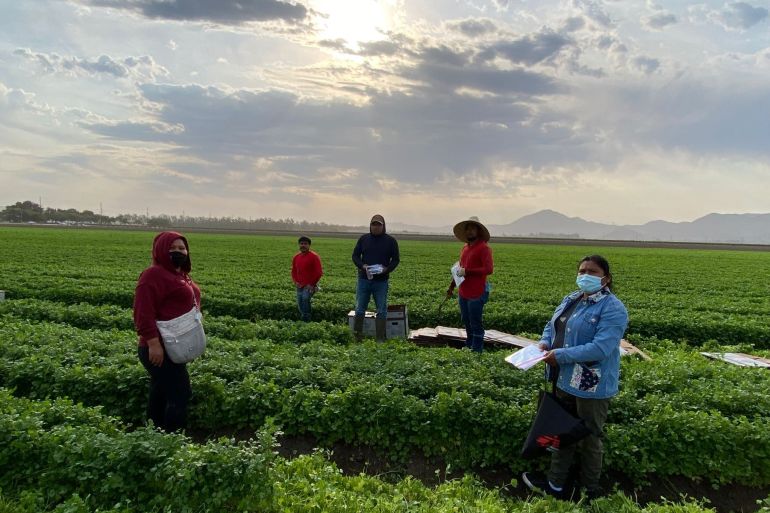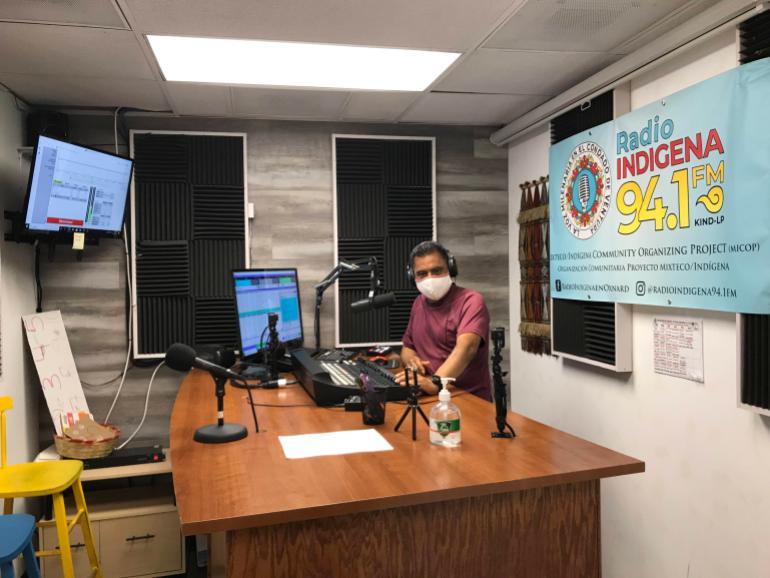Amid pandemic, Indigenous Mexican workers in US fight to be heard
With few resources available in their native languages, many are finding a lifeline in community organisations.

Oxnard, California, United States – When Arcenio Lopez made the journey to the United States from his hometown of San Francisco Higos in the Mexican state of Oaxaca in 2003, he was just 21 years old. Spanish was commonly heard in his hometown, along with Mixteco, a language spoken by Indigenous Mixtec, or Nuu Savi, communities in southern Mexico.
In California, Lopez found work in the strawberry fields surrounding a small city called Oxnard in Ventura County, around 100 kilometres (62 miles) northwest of Los Angeles.
Keep reading
list of 4 itemsGuatemala: Indigenous women celebrate ruling on sexual violence
Telling Indigenous stories: ‘I’m fighting to be heard’
In Pictures: The Indigenous town in Mexico living on remittances
Many workers who spent hours hunched over picking berries also had origins in Indigenous communities in Mexico, and spoke native languages such as Mixteco, Zapoteco, Purepecha and Triqui. Some spoke little Spanish, inciting scorn from Mexican foremen and some colleagues in the fields who looked down on Indigenous workers.
Lopez, now the executive director of the Mixteco Indigena Community Organizing Project (MICOP), which serves the Mexican Indigenous population of Oxnard and several neighbouring counties in southern California, says anti-Indigenous racism continues to follow workers across the border. “This goes all the way back to the history of colonisation,” he told Al Jazeera. “We carry this trauma in our DNA.”
The COVID-19 pandemic has brought additional challenges, as community members struggle to find resources in Indigenous languages and to take advantage of public programmes for vaccination and testing, after decades of immigrants being discouraged from utilising public assistance.
Community groups have thus stepped in to bridge the gulf of trust between the government and Indigenous migrant workers.
Legacy of discrimination
Even before the pandemic, advocates have said anti-Indigenous racism and a lack of resources in native languages made Indigenous workers vulnerable to abuse and exploitation, including wage theft.
“A lot of farm labour is paid by the piece,” Jorge Toledano, a Mixtec community organiser with MICOP, told Al Jazeera. “If an Indigenous worker brings in a basket of strawberries, the supervisor might cheat them by marking it down as less fruit than is actually there in a language they don’t know, so the worker gets paid less.”
Sarait Martinez, an Indigenous Zapotec who heads the Centro Binacional para el Desarrollo Indigena Oaxaqueno (CBDIO) in California’s Central Valley, said there is “a lot of anti-Indigenous racism in the Mexican community”.
“It can be intimidating for people to demand their rights,” Martinez told Al Jazeera. “But if you work up the courage to contact the government to tell them about a workplace violation, what do you do if no one at the agency speaks your language?”
Such language barriers can have lethal consequences. In July 2021, Gerardo Martinez, a 19-year-old Zapotec man, was shot and killed by police in the city of Salinas. Martinez was holding what appeared to be a handgun and did not respond to demands from police given in Spanish. But the weapon in question turned out to be a BB gun, and Martinez was a monolingual native speaker who did not understand Spanish.
California has never thoroughly surveyed the state’s Mexican Indigenous population, and estimates of their size and composition in the labour force vary. The most comprehensive effort was the Indigenous Farmworker Study, carried out by the California Endowment and California Rural Legal Assistance in 2010.
The study estimated that there were approximately 120,000 Mexican Indigenous farmworkers in California, mostly in the Central Valley and Central Coast regions. Yet, despite their substantial representation in California’s $50bn agricultural industry, Martinez says authorities have shown only limited interest in understanding such communities – although this has started to change during the pandemic, amid growing pressure from Indigenous advocates.
“We ask counties and different departments how they track Indigenous needs, like language needs, and they don’t have an answer,” Martinez said. “Institutions are not allocating the right amount of resources to ensure our communities have access to information and services in their languages. The fact that we’re invisible among those services really impacts the way they serve us.”
Lilia Garcia-Brower, the California state labour commissioner who oversees enforcement of wage and hour laws, told Al Jazeera that her office has worked with community organisations before and during the pandemic, and has partnered with MICOP and CBDIO on “labour caravans” that seek to inform workers of their rights.
“One of the ways to ensure we’re available to workers is to partner with organisations the community trusts. We want to make sure those relationships continue,” Garcia-Brower said. “Those investments are one component, but they also can’t replace a more institutional effort to accommodate workers in multiple languages.”
Navigating COVID-19
During the pandemic, a lack of information in native languages has created confusion, leaving gaps quickly filled by rumours and conspiracy theories. “If you can’t find answers to your questions, maybe you look to social media instead,” said Lopez, who recently penned a column highlighting the spread of misinformation among Mexican Indigenous communities on social media.
Groups such as MICOP have used radio stations to share information on the pandemic, worker’s rights and updates to immigration law, all in Indigenous languages. In Oxnard, MICOP runs 94.1 Radio Indigena, which features 40 hours of weekly live programming in Spanish, Zapoteco, Purepecha and a variety of Mixteco dialects.
In the Central Valley, a station called Radio Bilingue also offers programmes in Spanish and Mixteco. Many staff at these stations are Indigenous, making them a reliable source because of their roots in the communities they aim to reach.
Keeping up with constantly shifting pandemic guidelines and updates – and translating all of that information into many languages – is time-intensive. To deal with the scale of need in the community, MICOP has expanded from 70 staff to 120 since March 2020, Lopez said, “Delta, Omicron, new CDC guidelines; we have to stay on top of all this information, then translate it into several languages so it can reach people in a timely manner.”

The difficulty has been heightened by a political climate in which migrants, especially the undocumented, are hesitant to ask the state for assistance. Even workers who are entitled to use government programmes often avoid doing so, worried that relying on welfare programmes could hurt their chances of obtaining citizenship.
In such an atmosphere, admonitions by the state to get tested and vaccinated for free may appear contradictory. “It’s hard to undo something that has been so ingrained for such a long time,” Martinez said.
While community groups can help to bridge the gap between state institutions and community members, that responsibility – largely due to a void left by government agencies – can also be exhausting. “There’s collaboration we haven’t seen before with the state,” Martinez said. “We’d like to ensure the changes we see are structural, and there are more agencies hiring people who speak these languages.”
Toledano, despite the challenges his community faces, feels hopeful about the future because of the power in organising. When he first came to California, he saw a video of legendary labour rights activist Cesar Chavez and was spurred into workplace organising.
“When we’re divided, we can be taken advantage of,” Toledano said. “But when we fight together, then we’re in charge and we can demand our rights. Nothing will change until we make them hear us.”